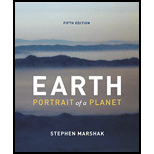
a)
With reference to the graph in Box
a)
Answer to Problem 26OFT
From the graph, a flood with a discharge of
Explanation of Solution
The graph given in Box
The graph gives a recurrence interval of
Then, the annual probability of a
b)
With reference to the graph in Box
b)
Answer to Problem 26OFT
A flood with a discharge of 200 cubic feet per second would be about
Explanation of Solution
The graph given in Box
The recurrence interval of a flood with a discharge of 200 cubic feet per second would be nearly one year, while that of a flood with a discharge of 400 cubic feet per second is around five. Thus, the likeliness of a flood with a discharge of 200 cubic feet per second may be
c)
For the purpose of discussion, imagine that the floodplain of the river that gets totally inundated when a flood with an annual probability of 1/300 befalls. Find whether people will build a new home in the floodplain, whether it makes a difference if the last flood with this probability occurred one year ago, and whether it makes a difference if the last flood with this probability occurred one hundred years ago.
c)
Answer to Problem 26OFT
It is certain that the floodplains are not safer sites for new constructions. Suppose for a
Explanation of Solution
Given info:
The annual probability of the flood is given as
The annual probability or annual exceedance probability represents the likelihood of occurrence of a flood of a given size or more at a definite area in any given year. There is another term related to the occurrence of a flood, which is called the “recurrence interval of a flood”. The recurrence interval of a flood of a given size refers to the average number of years amid the occurrence of successive floods of at least the specified size.
The annual probability and recurrence interval can be related by the following equation:
From the above equation, the recurrence interval can be expressed as follows:
Substitute the value of annual probability as
Thus, it is a
The annual probability of the
Assume that the home ownership on the floodplain is for
Substitute the value of annual probability as
Hence, during the
Due to this, it is not important whether a
Want to see more full solutions like this?
Chapter 17 Solutions
Earth: Portrait of a Planet (Fifth Edition)
 Applications and Investigations in Earth Science ...Earth ScienceISBN:9780134746241Author:Edward J. Tarbuck, Frederick K. Lutgens, Dennis G. TasaPublisher:PEARSON
Applications and Investigations in Earth Science ...Earth ScienceISBN:9780134746241Author:Edward J. Tarbuck, Frederick K. Lutgens, Dennis G. TasaPublisher:PEARSON Exercises for Weather & Climate (9th Edition)Earth ScienceISBN:9780134041360Author:Greg CarbonePublisher:PEARSON
Exercises for Weather & Climate (9th Edition)Earth ScienceISBN:9780134041360Author:Greg CarbonePublisher:PEARSON Environmental ScienceEarth ScienceISBN:9781260153125Author:William P Cunningham Prof., Mary Ann Cunningham ProfessorPublisher:McGraw-Hill Education
Environmental ScienceEarth ScienceISBN:9781260153125Author:William P Cunningham Prof., Mary Ann Cunningham ProfessorPublisher:McGraw-Hill Education Earth Science (15th Edition)Earth ScienceISBN:9780134543536Author:Edward J. Tarbuck, Frederick K. Lutgens, Dennis G. TasaPublisher:PEARSON
Earth Science (15th Edition)Earth ScienceISBN:9780134543536Author:Edward J. Tarbuck, Frederick K. Lutgens, Dennis G. TasaPublisher:PEARSON Environmental Science (MindTap Course List)Earth ScienceISBN:9781337569613Author:G. Tyler Miller, Scott SpoolmanPublisher:Cengage Learning
Environmental Science (MindTap Course List)Earth ScienceISBN:9781337569613Author:G. Tyler Miller, Scott SpoolmanPublisher:Cengage Learning Physical GeologyEarth ScienceISBN:9781259916823Author:Plummer, Charles C., CARLSON, Diane H., Hammersley, LisaPublisher:Mcgraw-hill Education,
Physical GeologyEarth ScienceISBN:9781259916823Author:Plummer, Charles C., CARLSON, Diane H., Hammersley, LisaPublisher:Mcgraw-hill Education,





